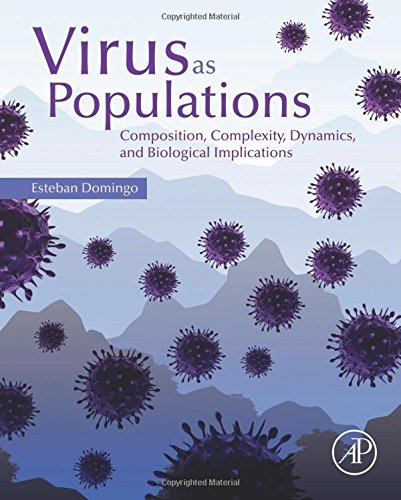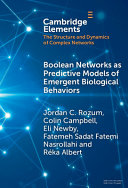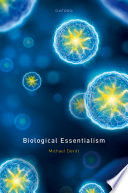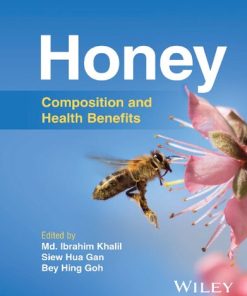Virus as populations composition complexity dynamics and biological implications 1st Edition by Esteban Domingo 0128009942 9780128008379 9780128009949
$50.00 Original price was: $50.00.$25.00Current price is: $25.00.
Virus as populations : composition, complexity, dynamics, and biological implications 1st Edition by Esteban Domingo – Ebook PDF Instant Download/DeliveryISBN: 0128009942, 9780128008379, 9780128009949
Full download Virus as populations : composition, complexity, dynamics, and biological implications 1st Edition after payment.

Product details:
ISBN-10 : 9780128008379
ISBN-13 : 9780128009949
Author : Esteban Domingo 0128009942
Virus as Populations: Composition, Complexity, Dynamics, and Biological Implications explains fundamental concepts that arise from regarding viruses as complex populations when replicating in infected hosts. Fundamental phenomena in virus behavior, such as adaptation to changing environments, capacity to produce disease, probability to be transmitted or response to treatment, depend on virus population numbers and in the variations of such population numbers. Concepts such as quasispecies dynamics, mutations rates, viral fitness, the effect of bottleneck events, population numbers in virus transmission and disease emergence, new antiviral strategies such as lethal mutagenesis, and extensions of population heterogeneity to nonviral systems are included. These main concepts of the book are framed in recent observations on general virus diversity derived from metagenomic studies, and current views on the origin of viruses and the role of viruses in the evolution of the biosphere.
Virus as populations : composition, complexity, dynamics, and biological implications 1st Table of contents:
Chapter 1: Introduction to Virus Origins and Their Role in Biological Evolution
Abstract
1.1 Considerations on Biological Diversity
1.2 Some Questions of Current Virology and the Scope of This Book
1.3 The Staggering Ubiquity and Diversity of Viruses: Limited Morphotypes
1.4 Origin of Life: A Brief Historical Account and Current Views
1.5 Theories of the Origins of Viruses
1.6 Being Alive Versus Being Part of Life
1.7 Role of Viruses in the Evolution of the Biosphere
1.8 Virus and Disease
1.9 Overview and Concluding Remarks
Chapter 2: Molecular Basis of Genetic Variation of Viruses: Error-Prone Replication
Abstract
2.1 Universal Need of Genetic Variation
2.2 Molecular Basis of Mutation
2.3 Types and Effects of Mutations
2.4 Inferences on Evolution Drawn from Mutation Types
2.5 Mutation Rates and Frequencies for DNA and RNA Genomes
2.6 Evolutionary Origins, Evolvability, and Consequences of High Mutation Rates: Fidelity Mutants
2.7 Hypermutagenesis and Its Application to Generate Variation: APOBEC and ADAR Activities
2.8 Error-Prone Replication and Maintenance of Genetic Information: Instability of Laboratory Viral Constructs
2.9 Recombination in DNA and RNA Viruses
2.10 Genome Segment Reassortment
2.11 Transition Toward Viral Genome Segmentation: Implications for General Evolution
2.12 Mutation, Recombination, and Reassortment as Individual and Combined Evolutionary Forces
2.13 Overview and Concluding Remarks
Chapter 3: Darwinian Principles Acting on Highly Mutable Viruses
Abstract
3.1 Theoretical Frameworks to Approach Virus Evolution
3.2 Genetic Variation, Competition, and Selection
3.3 Mutant Distributions During DNA and RNA Virus Infections
3.4 Positive Versus Negative Selection: Two Sides of the Same Coin
3.5 Selection and Random Drift
3.6 Viral Quasispecies
3.7 Sequence Space and State Transitions
3.8 Modulating Effects of Mutant Spectra: Complementation and Interference: An Ensemble as the Unit of Selection
3.9 Viral Populations in Connection with Biological Complexity
3.10 Overview and Concluding Remarks
Chapter 4: Interaction of Virus Populations with Their Hosts
Abstract
4.1 Contrasting Viral and Host Population Numbers
4.2 Types of Constraints and Evolutionary Trade-Offs in Virus-Host Interactions
4.3 Codon Usage as a Selective Constraint: Virus Attenuation Through Codon and Codon-pair Deoptimization
4.4 Modifications of Host Cell Tropism and Host Range
4.5 Trait Coevolution: Mutual Influences Between Antigenic Variation and Tropism Change
4.6 Escape from Antibody and Cytotoxic T Cell Responses in Viral Persistence: Fitness Cost
4.7 Antigenic Variation in the Absence of Immune Selection
4.8 Constraints as a Demand on Mutation Rate Levels
4.9 Multifunctional Viral Proteins in Interaction with Host Factors: Joker Substitutions
4.10 Alternating Selective Pressures: The Case of Arboviruses
4.11 Overview and Concluding Remarks
Chapter 5: Viral Fitness as a Measure of Adaptation
Abstract
5.1 Origin of the Fitness Concept and Its Relevance to Viruses
5.2 The Challenge of Fitness In Vivo
5.3 Fitness Landscapes
5.4 Population Factors on Fitness Variations: Collective Fitness and Perturbations by Environmental Heterogeneity
5.5 Quasispecies Memory and Fitness Recovery
5.6 The Relationship Between Fitness and Virulence
5.7 Fitness Landscapes for Survival: The Advantage of the Flattest
5.8 Fitness and Function
5.9 Epidemiological Fitness
5.10 Overview and Concluding Remarks
Chapter 6: Virus Population Dynamics Examined with Experimental Model Systems
Abstract
6.1 Value of Experimental Evolution
6.2 Experimental Systems in Cell Culture and In Vivo
6.3 Viral Dynamics in Controlled Environments: Alterations of Viral Subpopulations
6.4 Persistent Infections in Cell Culture: Virus-cell Coevolution
6.5 Teachings from Plaque-to-Plaque Transfers
6.6 Limits to Fitness Gain and Loss
6.7 Competitive Exclusion Principle and Red Queen Hypothesis
6.8 Studies with Reconstructed Quasispecies
6.9 Quasispecies Dynamics in Cell Culture and In Vivo
6.10 Overview and Concluding Remarks
Chapter 7: Long-Term Virus Evolution in Nature
Abstract
7.1 Introduction to the Spread of Viruses. Outbreaks, Epidemics, and Pandemics
7.2 Reproductive Ratio as a Predictor of Epidemic Potential. Indeterminacies in Transmission Events
7.3 Rates of Virus Evolution in Nature
7.4 Long-term Antigenic Diversification of Viruses
7.5 Comparing Viral Genomes. Sequence Alignments and Databases
7.6 Phylogenetic Relationships Among Viruses. Evolutionary Models
7.7 Extinction, Survival, and Emergence of Viral Pathogens. Back to the Mutant Clouds
7.8 Overview and Concluding Remarks
Chapter 8: Quasispecies Dynamics in Disease Prevention and Control
Abstract
8.1 Medical Interventions as Selective Constraints
8.2 Different Manifestations of Virus Evolution in the Prevention and Treatment of Viral Disease
8.3 Antiviral Vaccines and the Adaptive Potential of Viruses
8.4 Resistance to Antiviral Inhibitors
8.5 Molecular Mechanisms of Antiviral Resistance
8.6 Antiviral Resistance Without Prior Exposure to Antiviral Agents
8.7 Fitness or a Fitness-Associated Trait as a Multidrug-Resistance Mechanism
8.8 Viral Load, Fitness, and Disease Progression
8.9 Limitations of Simplified Reagents and Small Molecules as Antiviral Agents
8.10 “Hit Early, Hit Hard”
8.11 Information and Global Action
8.12 Overview and Concluding Remarks
Chapter 9: Trends in Antiviral Strategies
Abstract
9.1 The Challenge
9.2 Practiced and Proposed Strategies to Confront the Moving Target Challenge with Antiviral Inhibitors
9.3 Lethal Mutagenesis and the Error Threshold
9.4 Virus Extinction by Mutagenic Agents
9.5 Lethal Mutagenesis In Vivo: Complications Derived From Multiple Mechanisms of Drug Action—The Case of Ribavirin
9.6 Virus Resistance to Mutagenic Agents: Multiple Mechanisms and Evidence of Abortive Escape Pathways
9.7 Virus Extinction as the Outcome of Replacement of Virus Subpopulations: Tempo and Mode of Mutation Acquisition
9.8 The Interplay Between Inhibitors and Mutagenic Agents in Viral Populations: Sequential Versus Combination Treatments
9.9 Prospects for a Clinical Application of Lethal Mutagenesis
9.10 Some Atypical Proposals
9.11 Overview and Concluding Remarks
Chapter 10: Collective Population Effects in Nonviral Systems
Abstract
10.1 Concept Generalization
10.2 Viruses and Cells: The Genome Size-Mutation-Time Coordinates Revisited
10.3 Darwinian Principles and Intrapopulation Interactions Acting on Cell Populations
10.4 The Dynamics of Unicellular Parasites in the Control of Parasitic Disease
10.5 Cancer Dynamics: Heterogeneity and Group Behavior
10.6 Collective Behavior of Prions
10.7 Molecular Mechanisms of Variation and Clonality in Evolution
10.8 Genomes, Clones, Consortia, Networks, and Power Laws
10.9 An Additional Level of Virus Vulnerability?
10.10 Overview and Concluding Remarks
People also search for Virus as populations : composition, complexity, dynamics, and biological implications 1st:
virus population
population of viruses
disease and population
disease population control
epstein barr virus population
Tags: Virus as populations, composition, complexity, dynamics, biological implications, Esteban Domingo
You may also like…
Computers - Networking
Science (General) - Theories of Science
Business & Economics
Medicine - Natural Medicine
Biology and other natural sciences - Biology
Business & Economics - Management & Leadership
Entrepreneurship as Networking: Mechanisms, Dynamics, Practices, and Strategies Tom Elfring
Biology and other natural sciences












